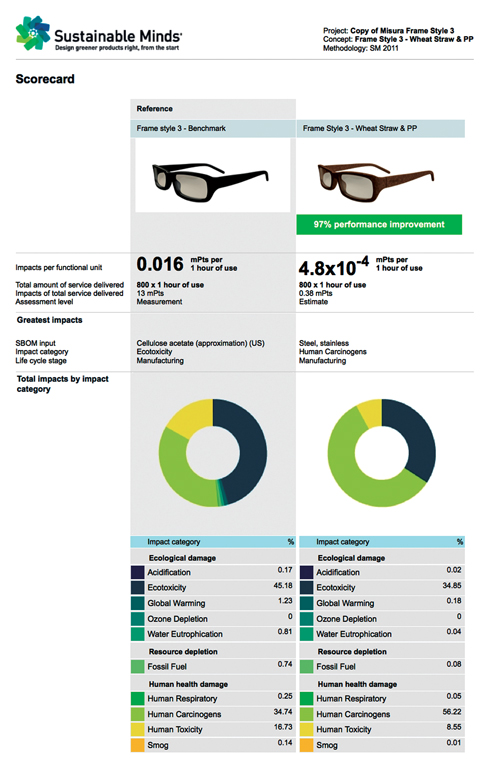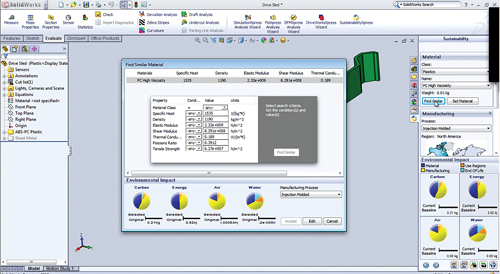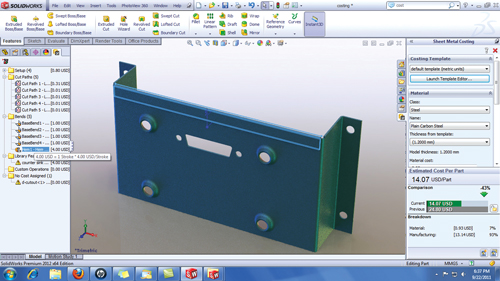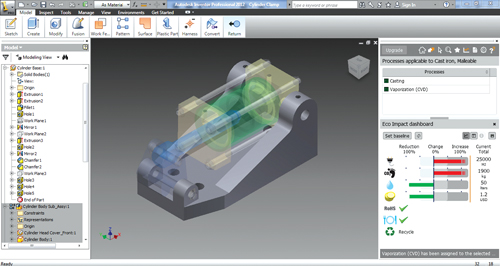Latest News
January 1, 2012
By Kenneth Wong
The sleek mobile tablet at your fingertips, the stylish sunglasses in your pocket, and the point-and-shoot camera you use to capture your Kodak moments—they all have an ecological lifespan that’s much longer than you think. The time the product remains in your possession—its duration of operation and service—may be just a few months (a pair of sunglasses) to a couple of years (a tablet or a digital camera), but its ecological footprint has been established long before you pick it up from your local mall. It will continue to grow long after its disposal. A series of decisions made in the manufacturing process—using polycarbonate instead of scratch-resistant borosilicate materials for a lens, or using injection molding instead of machining for a latch—affects a product’s environmental impact.
Depending on the size of the product and the ease with which it can be recycled, many products will likely end up in a waste stream, literally swelling the size of a landfill somewhere. Many city-dwelling consumers would gladly reclaim some precious countertop and desktop space by getting rid of old microwaves, broken electric fans, and damaged LCD monitors, but, confronted with inconvenient disposal options, they’ll be tempted to dump them with the trash or leave them in a street corner.
Developed first and foremost to express a product’s geometric shape, most engineering software titles can now help you evaluate a design’s aesthetics (with photorealistic rendering), durability (with finite element analysis), and manufacturability (with simulation of computer-controlled machining), but they’re still primitive when it comes to environmental assessment. However, in the last few years, a number of companies have begun to develop software tools to address lifecycle assessment (LCA).
 Using Sustainable Minds’ browser-based environmental impact calculator, designers at Fred Sparks examine greener alternatives to existing solutions. Shown here is a comparative report of different versions of sunglasses. |
There’s still no consensus on where the lifecycle begins and ends: In your environmental assessment of a design, should you, for instance, include the ecological impact of early prototypes later discarded? But most LCA software users and software developers seem to agree that impact calculation has to include more than the manufacturing bill of materials (BOM).
A Sustainable Baseline
The office of Fred Sparks, an industrial design agency, is perched along South Kingshighway Boulevard, within a short distance from Tower Grove Park in St. Louis. The firm has, quite literally, helped shaped many familiar household products, ranging from football helmets and golf bags to outdoor furniture.
Who is Fred, you ask? Well, there is no Fred per se. It’s just a personification of the three founders: Ken Harris, Aaron Brookhart and Brandon Hefer.
Fred Sparks is often hired as a design consultant to develop sustainable solutions to existing products. Because its role is consultative, the firm doesn’t always have access to 3D CAD models of the products. “Sometimes, those files exist in a factory somewhere in China, and the factory doesn’t want to give up that ]intellectual property],” observes Harris.
By contrast, Harris finds that it’s a lot easier to obtain a physical unit of the product itself, allowing him and his team to disassemble it to understand how its subcomponents work together. For Fred Sparks, the ideal LCA software turns out to be Sustainable Minds, an environmental impact assessment program delivered in a browser-based interface.
Terry Swack, co-founder and CEO of the program’s eponymous, Cambridge, MA-based manufacturing company, will tell you there is no such thing as a green product. There are only greener products. Every product has some impact on the environment. Nevertheless, as responsible designers, you can make an effort to reduce the anticipated impact, or find an alternative that creates the least impact. For consultants like Fred Sparks, the first task is establishing a baseline.
“We have to know what the impact of a particular product is,” says Harris. “We can disassemble an object, weigh its materials, use Sustainable Minds to get a benchmark, then we use different design strategies to reduce the environmental footprint.”
System BOM
Just as CAD users would catalog the content of their assembly in a BOM, Sustainable Minds subscribers use the software’s web-based input system to create an itemized bill of a product’s lifecycle. In this case, the lifecycle includes not only a list of objects to be manufactured (camera housing, lens, battery, memory chip release latch, etc.), but certain aspects of manufacturing that are bound to have an impact on the environment as well—such as transportation methods, choice of materials, and disposal methods.

First released as an optional module, SolidWorks Sustainability Xpress has
since become a standard design evaluation tool in subsequent releases of the
software. Shown here is the software’s dialog window, suggesting similar
materials that may be greener or less costly.
You might think of Sustainable Minds as the LCA equivalent of TurboTax. Whereas TurboTax will automatically tally up your income statements and deductions, and provide you with an amount owed to the government, Sustainable Minds provides you with an estimated eco-impact of your design, calculated using the TRACI metrics (Tool for the Reduction and Assessment of Chemical and Other Environmental Impacts) developed by the U.S. Environmental Protection Agency’s (EPA’s) Office of Research and Development. Measurements are made primarily in anticipated carbon dioxide (CO2) volume, with accompanying assessments for ecological damage, human health damage, and resource depletion.
One of the much-debated items on Sustainable Minds’ system BOM may be the line item dubbed “Unit of Measure” for measuring the impact of a product over its life expectancy. “It’s an estimate,” Harris acknowledges, “but as long as you use the same unit of measurement for two different concepts, as long as their lifecycles are the same, your comparison will be valid—like comparing apples to apples.”
For example, Fred Sparks is currently engaged in designing (or redesigning) a brand of ready-made reading eyewear, the kind you can purchase at your local drugstore without a prescription.

In SolidWorks 2012, the software adds a cost analysis module, allowing you
to weigh a product’s manufacturing cost against its sustainable features.
“We interviewed some consumers, found out the frequency of use, asked them how long their readers lasted, then we figured out the ]unit of service] by ]multiplying] the typical hours of usage per day with the lifespan of the glasses,” Harris explains.
In seeking greener alternatives, the team discovered that “manufacturing methods and transportations are big ]impact generators], because we now make so many products in Asia and import them,” he adds.
Sustainable Minds software allows Harris and his colleagues to play what-if scenarios, by switching materials, manufacturing options and transportation options. Fred Sparks also investigates possible secondary use: For instance, a product package that can be reused as a stand reduces the consumer’s tendency to throw away the package after unwrapping.
“We look at designing packaging to make it apparent that it can be recycled,” Harris adds. “We look at developing recycling programs at end of life. During brainstorming sessions, we look at all of those strategies.”
Still, Harris admits, some metrics are not guaranteed: Consumers may still choose to dispose of the product improperly instead of recycling it.
CAD Integration
Sustainable Minds works as a standalone web-based program, but the company has worked with Autodesk to ensure that, if you upload a BOM exported from Autodesk Inventor CAD package, the appropriate fields are automatically populated with the right numbers—for instance, component volumes and material specifications, as deduced from the 3D CAD assembly model.
Increased attention to LCA and green design has prompted some CAD software makers to add environmental impact assessment tools to their 3D modeling interface. SolidWorks and Autodesk Inventor—two fierce competitors in the design software market—have both incorporated the function.
First released as in 2009, SolidWorks Sustainability Xpress has since become a standard part of the software’s design evaluation tools, taking its place alongside stress and surface analysis tools. Once you’ve specified material choices and manufacturing methods for a part, Sustainability Xpress can begin calculating its environmental impact, expressed in four categories: carbon emission, energy usage, air pollution and water pollution. The module also lets you identify materials with similar strength and cost that might be a better substitute (that is, greener or cheaper materials).
In the optional module SolidWorks Sustainability (which requires an additional fee), you can evaluate the impact of entire assemblies, not just parts. In addition to metrics available in Xpress, the full version of Sustainability takes transportation into account in its calculations.

Based on your input, Autodesk Inventor’s Eco Materials Adviser gives you
an estimateof your design’s eco impact, along with its cost and Restriction of
Hazardous Substances Directive (RoHS)-compliant status.
A little more than a year after the debut of SolidWorks Sustainability Xpress, Autodesk released its version, called Eco Materials Adviser. Integrated right into the 3D modeling interface of Autodesk Inventor, the module lets you obtain estimates on your design’s manufacturing cost, water usage, energy usage and carbon footprint. The initial release of Eco Materials Adviser is meant for parts analysis only, not assemblies. SolidWorks Sustainability Xpress allows you to evaluate multiple designs with different geometry (for instance, comparing two versions of a camera housing with different wall thicknesses), and generate a comparison report. To perform a similar task in Autodesk Eco Materials Adviser, you’ll need to run two different sessions of analysis (one for each version of the design) and compare the reports on your own.
Three Pillars
In most engineering software, basic stress analysis tools have become standard, providing designers and engineers with an easy way to evaluate the structural integrity of their proposed design. Current crops of LCA tools may be harbingers of things to come, paving the way for such features to become the norm.
“Sustainable is here to stay, by way of consumer desire or government regulation,” says Harris. “Those who’re not making it part of their offerings, either as design consultants or manufacturers, are going to miss the boat—and somebody will each their lunch.”
But a sustainable product with a high price tag isn’t a practical solution. In the final analysis, cost still drives most consumers’ purchasing decisions. It’s also a critical factor that dictates most manufacturing decisions, such as choice of materials, production sites and manufacturing methods. (In the latest release of SolidWorks, the software adds a cost estimation module to its 3D modeling interface.)
In the service industry, conventional wisdom suggests you can reasonably expect—and get—two of the three basic characteristics: fast, cheap or good. If the service is fast and cheap, it won’t be good; if it’s cheap and good, it won’t come fast; and if it’s good and fast, it won’t come cheap. Most service providers will tell you that to expect a service to be all three is just unreasonable.
In manufacturing today, the challenge is to find the right balance of durability (how well does the product perform under duress?), sustainability (how safe is it for the environment?), and cost (how much does it cost to make it?). It is, indeed, a tall order to come up with a design that satisfies all three criteria, but such is the demand of the consumers today.
Kenneth Wong is senior editor of Desktop Engineering. Contact him via [email protected], at deskeng.com/virtual_desktop or via Twitter @KennethwongSF.
MORE INFO
Subscribe to our FREE magazine, FREE email newsletters or both!
Latest News
About the Author
Kenneth Wong is Digital Engineering’s resident blogger and senior editor. Email him at [email protected] or share your thoughts on this article at digitaleng.news/facebook.
Follow DE





